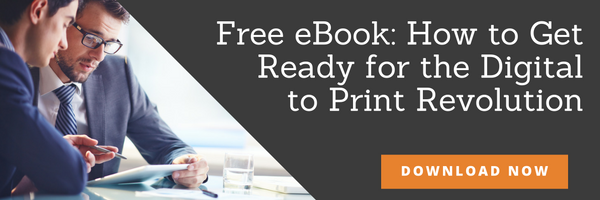Direct mail marketing hasn’t typically been given much consideration by digital marketers — until recently. Today’s direct mail is just as technology- and data-reliant...

Today’s marketing landscape presents tremendous opportunities for any company that wants to take its customer insights to the next level. The information available to marketers online drives the data-driven marketing and customer-focused marketing movements that are necessary for brands who truly strive to put the customer at the center of their business. After all, it’s the data your customers provide from their interactions with you that gives you the insights to know exactly who they are and what motivates them.
However, there’s a missing piece to this increasingly commonplace formula. Gathering consumer data online is a necessary component of any data-driven marketing philosophy, but that data doesn’t have to stay online. Applying your online insights to offline forms of marketing, such as direct mail, can help customers become even more immersed in their favorite brands, increasing their loyalty while simultaneously boosting the company’s revenues.
Customer-Focused Strategy Is Data-Driven
Much has been made of the modern-day focus on the customer experience and marketing to each member of a customer base on an individual level. Given the wealth of data available about each consumer and the personalization technology available, this is the ideal approach.
That data, though, can become somewhat of an albatross if the data collection and analysis is misused or misapplied. It’s not simply enough to store information about your customers and use it to drive the next pre-packaged marketing event. Going the extra mile to understand your audience as much as possible is what helps customers to feel valued. In today’s world, that perceived value is what breeds loyalty and long-term revenue.
How do you use data to understand your customers? Simply put, marketing to a customer means understanding what motivates them and what will encourage them to take the next step. Mining your website and social media accounts for intent data will help you to identify people who are on the verge of making a purchase. You can then isolate these customers and begin reaching out to them on a personal level. While it might seem intuitive to make this approach through digital means, there are other tools you can use to reach out to customers.
Programmatic Meets Print
The typical flow of operations in the buyer’s journey suggests that when prospects leave digital clues regarding their interests, the company should follow up by sending emails focusing on the items in which they are interested. But why use only digital tactics to appeal to these customers?
Consider the fact that online shoppers are targeted hundreds, if not thousands, of times each day. Also consider that the vast majority of these shoppers are well-versed in tuning out digital advertisements, even from brands they care about. In short, even the most motivated buyers may avoid your targeted digital marketing efforts.
Fortunately, there’s a different way to approach the situation. Modern technology makes it possible to use the same technology that triggers an automated email, while sending the message in a tangible offline format. The system works the exact same way as it does digitally. Everything you can do in a triggered email, you can do in print.
But there’s much, much more to the puzzle than simply taking a different route towards enticing a potential customer to make a purchase. Direct mail has a response rate that’s much higher than that of email marketing and paid search. In terms of providing a friendly reminder to an interested party, offline methods are far more effective than digital formats. You can easily lose track of an email, but you can easily save a postcard or printed letter anywhere you want.
For example, imagine a consumer is interested in buying a purse from your online store. You know she wants the purse because of how she has behaved on your company’s website. She’s spent considerable time viewing the product page, she’s read the reviews on your site and she’s put the item into her shopping cart. However, something kept her from making that purchase when she was conducting her research. Instead of sending another email that may go directly into her spam folder, programmatic print capabilities can automatically send her a personalized postcard with a value-added offer to entice her to check out, either online or in-store. Now, she can put that postcard by her computer, in her current purse, in her car or in any other location that will help her to remember to finalize her purchase.
By moving the marketing offline, you’ve done more than find a new way to connect with your prospective customer. You’ve proven that you understand her, and you’ve shown that you want to provide the information necessary for her to make the right choice.
CMOs Must Be Agile
No CMO ever reached the top of an industry by doing things the way they’ve always been done. It takes a special mind to move a business forward. Those who recognize that data-driven, customer-focused marketing is the way of the future will have the best chance for success in the technology-driven future of marketing.
The CMOs of the future must be able to combine the best of both worlds. They must have the ability to tell a story while simultaneously allowing data to guide that story. In other words, the creativity and individualized appeal that’s been synonymous with marketing for decades is still an important part of the package, and that will never change. In fact, storytelling might be even more important in the data-driven era. People do want to be marketed to as individuals, but they don’t want to feel as if they’re receiving a robotic pitch that only pops up because of a specific pre-set marketing trigger. They still want a good reason to make a purchase. Data allows you to zero in on the what motivates your customers to purchase and what they consider valuable.
At the same time, it’s up to the CMO to oversee the responsible use of that data. The CMO drives the company’s philosophy regarding data, and everything the company does from a data perspective is a direct result of that philosophy. The CMO must encourage his or her team not to rely on assumptions, but to instead use data to its fullest potential and allow data to guide the company’s marketing approach. CMOs are also encouraged to use the data they’ve gathered online and find other ways to apply those insights, such as through direct mail.
Of course, data has far more uses than simply dictating the audience of the next campaign. Data enables CMOs to look at campaigns that have just ended so that they can evaluate what worked and what didn’t. Sometimes, a seemingly brilliant idea falls flat, while a different aspect of the campaign proves to be highly effective. The CMO has to be agile enough to evaluate these results and decide whether this was a one-time fluke or if it’s a sign of a changing marketplace.
Leveraging Data to Connect with Today’s Customers
Data-driven, customer-focused marketing is indeed the best way to reach the modern-day consumer. And although much of the data collection for this philosophy is collected online, that data also has applications beyond the digital world. Companies that take these insights and apply them to different forms of marketing are equipping themselves to touch customers in many different ways. This translates to a more informed and more educated customer, which results in a better customer experience, which ultimately brings about increased revenues and customer loyalty.

